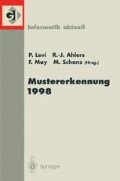Zusammenfassung
Die zuverlässige Detektion von Oberflächen oder Konturen in verrauschten Bildern erfordert den Einsatz von globalem Kontextwissen. Während bestehende Ansätze dieses Wissen für die Objektidentifikation in Merkmalsräumen einsetzen, die in unabhängigen Vorverarbeitungsschritten berechnet wurden, stellen wir einen Ansatz vor, der das Kontextwissen bereits bei der Extraktion lokaler Bildmerkmale verwenden kann. Zur Beschreibung des globalen Kontextes kommt dabei ein aktives Oberflächenmodell zum Einsatz, das mittels FEM realisiert wurde. Es wird exemplarisch die Anwendung auf Ultraschalldaten vorgestellt.
Access this chapter
Tax calculation will be finalised at checkout
Purchases are for personal use only
Preview
Unable to display preview. Download preview PDF.
Literatur
Mclnerney T, Terzopoulos D: A dynamic finite element surface model for segmentation and tracking in multidimensional medical images with application to cardiac 4D image analysis, Computerized Medical Imaging and Graphics, Vol. 19, No. 1, pp. 69–83, 1995
Cohen L, Cohen I: Finite-Elemente Methodes for Active Contour Models and Balloons for 2-D and 3-D Images, IEEE Trans. PAMI, Vol. 15, No. 11, 1993
Leymarie L, Levine MD: Tracking Deformable Objects in the Plane Using an Active Contour Model, IEEE Trans. PAMI, Vol. 15, No. 6, 1993
Chalana V et al.: A Multiple Active Contour Model for Cardiac Boundary Detection on Echocardiographic Sequences, IEEE Trans. Med. Img., Vol. 15, No. 3, 1996
Ronfard R: Region-Based Strategies for Active Contour Models, International Journal of Computer Vision, 13: 2, 229–251 (1994)
Dhatt G:Finite Elemente Methode Displayed, Wiley & Sons 1985, ISBN 047190110 5
Author information
Authors and Affiliations
Editor information
Editors and Affiliations
Rights and permissions
Copyright information
© 1998 Springer-Verlag Berlin Heidelberg
About this paper
Cite this paper
Schuckenberg, M., von Dziembowski, G., Meyer-Ebrecht, D. (1998). Erkennung deformierbarer Konturen und Oberflächen in verrauschten Bilddaten durch Einsatz modellgekoppelter anisotroper Merkmalsextraktoren. In: Levi, P., Schanz, M., Ahlers, RJ., May, F. (eds) Mustererkennung 1998. Informatik aktuell. Springer, Berlin, Heidelberg. https://doi.org/10.1007/978-3-642-72282-0_23
Download citation
DOI: https://doi.org/10.1007/978-3-642-72282-0_23
Publisher Name: Springer, Berlin, Heidelberg
Print ISBN: 978-3-540-64935-9
Online ISBN: 978-3-642-72282-0
eBook Packages: Springer Book Archive

